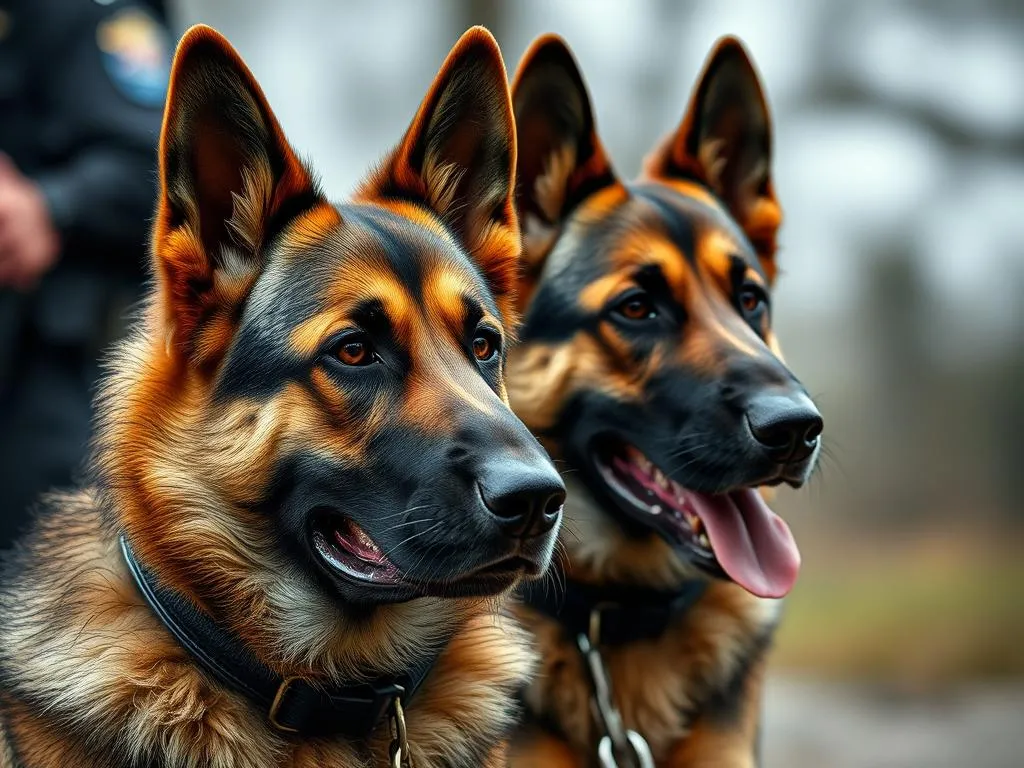
Introduction
The fascinating world of police dogs is one filled with loyalty, bravery, and exceptional skills. These four-legged heroes play a crucial role in law enforcement, assisting officers in various tasks that enhance public safety and crime prevention. With their acute senses and specialized training, police dogs have become indispensable partners to law enforcement agencies around the globe. In this article, we will explore the multitude of roles that police dogs fulfill, their rigorous training processes, and the many benefits they bring to law enforcement.
Overview of Police Dogs
Definition and Types of Police Dogs
Police dogs are specially trained canines that assist law enforcement officers in performing various tasks related to crime fighting and public safety. Several breeds are commonly used for police work, including German Shepherds, Belgian Malinois, and Bloodhounds. Each breed has unique traits that make them suitable for different roles within law enforcement.
- Patrol Dogs: These dogs are trained to assist officers in maintaining public order, tracking suspects, and apprehending criminals.
- Detection Dogs: Specialized canines trained to identify specific substances, such as narcotics or explosives.
- Search and Rescue Dogs: Dogs specially trained to locate missing persons, whether lost hikers or individuals in disaster scenarios.
Historical Context
The use of dogs in law enforcement dates back to ancient civilizations, where they were employed for hunting and guarding. However, the formal integration of police dogs into modern law enforcement began in the early 20th century, with the first known police dog unit established in Belgium in 1899. Over the years, the roles of police dogs have evolved significantly, adapting to new challenges that law enforcement faces in society.
Primary Roles of Police Dogs
Detection Work
Detection work is one of the primary functions of police dogs. These canines possess an extraordinary sense of smell, allowing them to identify various substances with incredible accuracy.
Drug Detection
Training for drug detection involves teaching dogs to recognize specific narcotics by scent. Police dogs undergo rigorous programs that include exposure to different drugs in controlled environments. Their success in this area has led to numerous drug busts, with dogs playing a vital role in uncovering hidden narcotics during traffic stops and raids.
For example, during a significant operation in 2021, a police dog named Max helped officers locate over 200 pounds of marijuana hidden in a vehicle, leading to the arrest of multiple individuals involved in drug trafficking.
Explosive Detection
Another critical area of expertise for police dogs is explosive detection. These dogs are trained to identify various types of explosives, including dynamite, C4, and even homemade bombs. Their keen sense of smell can detect trace amounts of explosives, making them invaluable in ensuring public safety during events that may be potential targets for terrorism.
In high-stakes situations, such as large public gatherings or sporting events, explosive detection dogs work alongside officers to scan for any potential threats, significantly enhancing security measures.
Patrol and Apprehension
Patrol and apprehension are dynamic roles that highlight the agility and bravery of police dogs.
Tracking Suspects
When a crime is committed, police dogs can track suspects using scent trails left behind. These dogs are trained to follow scents over various terrains, making them exceptionally effective in locating fleeing individuals. The tracking process involves a combination of instinct and training, allowing dogs to discern the age and direction of a scent.
One notable case involved a police dog named Duke, who successfully tracked a suspect for over three miles through dense woods, leading to the suspect’s apprehension and subsequent charges.
Apprehension of Criminals
In addition to tracking, police dogs are often deployed to assist in apprehending suspects. Their presence can deter criminals and provide officers with the necessary backup in potentially dangerous situations. When a suspect is apprehended, police dogs are trained to engage appropriately, ensuring the safety of both the officers and the canine.
Safety protocols are in place to protect the dogs during apprehension, including training in bite control and ensuring that the dog only engages when commanded by the handler.
Search and Rescue Operations
Search and rescue operations are another vital role for police dogs. These dogs are trained to locate missing persons in various environments, from urban settings to wilderness areas. Their acute sense of smell allows them to cover large areas quickly and efficiently.
Training for search and rescue scenarios involves simulating real-life situations where dogs learn to identify human scents. These skills are crucial during emergencies, such as natural disasters or missing person cases. A police dog’s ability to locate individuals can mean the difference between life and death, making them invaluable in these situations.
Crowd Control and Public Safety
Police dogs also play a significant role in crowd control and ensuring public safety. Their mere presence can help manage large crowds at events, deterring potential disturbances. Officers often deploy dogs at concerts, festivals, and sporting events to enhance security measures.
Handlers train their dogs to remain calm in chaotic environments, ensuring they can effectively assess situations without causing alarm. This proactive approach helps maintain order and fosters a sense of security among event attendees.
Training of Police Dogs
Initial Selection
The selection process for potential police dogs is meticulous. Not every dog is suited for law enforcement work; therefore, criteria such as temperament, energy levels, and physical fitness are evaluated. Breeds like German Shepherds and Belgian Malinois are often favored due to their intelligence and suitability for various tasks.
Basic Training
Once selected, police dogs undergo basic training, where they learn foundational skills such as obedience, commands, and socialization. This training is essential as it lays the groundwork for more specialized roles. Handlers play a critical role during this phase, establishing command and cooperation with their dogs.
Specialized Training
After completing basic training, dogs enter specialized programs tailored to their designated roles. This can range from narcotics detection to search and rescue operations. The duration and intensity of these programs can vary, but they often last several months, involving rigorous practice sessions and real-world simulations.
Handler-Dog Bonding
A strong bond between the handler and the police dog is crucial for effective teamwork. Handlers use various techniques to foster trust and cooperation, such as positive reinforcement and consistent training routines. This bond not only enhances performance but also ensures the safety of both the dog and the handler during operations.
Benefits of Using Police Dogs
Enhanced Law Enforcement Efficiency
Utilizing police dogs significantly enhances the efficiency of law enforcement agencies. Statistical evidence shows that the presence of dogs during operations leads to higher success rates in drug detection, tracking, and apprehensions. For instance, studies indicate that police dogs can locate drugs with an accuracy rate of over 90%.
Cost-Effectiveness
In addition to improving operational outcomes, police dogs offer a cost-effective solution for law enforcement agencies. While initial training and care costs can be substantial, the long-term benefits of employing dogs often outweigh these expenses. Compared to technological alternatives, such as surveillance systems, police dogs provide a versatile and dynamic resource that can adapt to various situations.
Community Relations
Police dogs also play an essential role in fostering positive community relations. These canines often participate in community events, school demonstrations, and public outreach programs, helping to humanize law enforcement and build trust between officers and the communities they serve. Their friendly demeanor and impressive skills can leave a lasting positive impression on the public.
Challenges and Considerations
Health and Welfare of Police Dogs
The health and welfare of police dogs are paramount. Common health issues, such as joint problems and heat-related illnesses, can arise due to the nature of their work. Regular veterinary care, wellness programs, and proper nutrition are essential components of maintaining the overall health of these working dogs.
Ethical Considerations
As the role of police dogs continues to evolve, ethical considerations regarding their treatment and training practices must be addressed. Ensuring humane treatment and training methods is essential for the welfare of the dogs and the integrity of law enforcement.
Public Perception and Misunderstandings
Public perception of police dogs can sometimes be clouded by misconceptions. Some people may view these dogs solely as tools for law enforcement, failing to recognize their intelligence, emotional depth, and the bond they share with their handlers. Educational initiatives aimed at informing the public about the capabilities and roles of police dogs can help foster understanding and appreciation.
Future of Police Dogs in Law Enforcement
Advances in Training Techniques
As canine behavior science continues to advance, so too does the training of police dogs. Innovative techniques are being adopted to enhance training effectiveness and improve the dogs’ response to various situations. Future training programs may incorporate new methods that consider the psychological well-being of the dogs while maximizing their performance.
Integration with Technology
The integration of technology into law enforcement is an exciting development for the future of police dogs. Drones and advanced tracking systems may complement the skills of police dogs, allowing for more efficient operations. As these technologies evolve, they will likely work in tandem with canine units to improve the effectiveness of law enforcement efforts.
Conclusion
The integral role of police dogs in law enforcement cannot be overstated. Their unique abilities and unwavering loyalty make them invaluable partners to officers on the front lines of public safety. As we move forward, it is essential to prioritize the ongoing support and proper care for these remarkable canines. Understanding their roles and contributions can help foster a greater appreciation for the bond between police dogs and their handlers, ensuring they continue to serve and protect our communities effectively.









